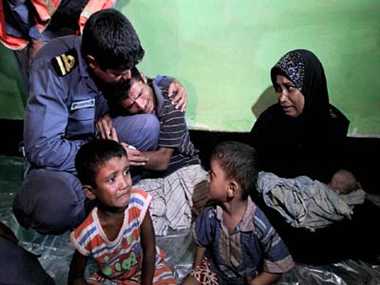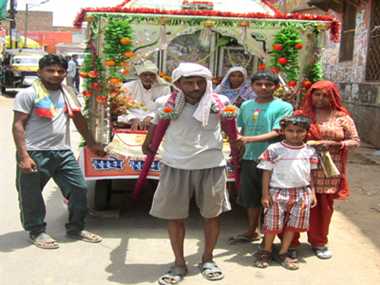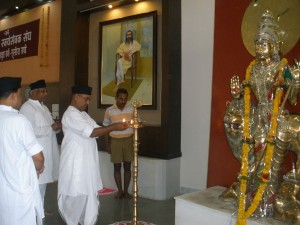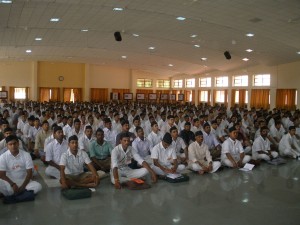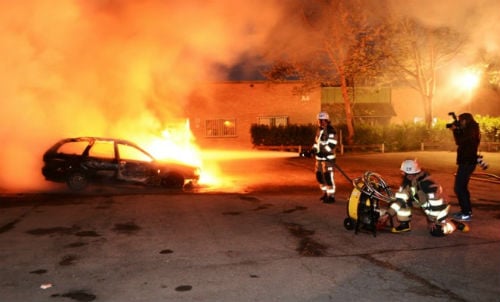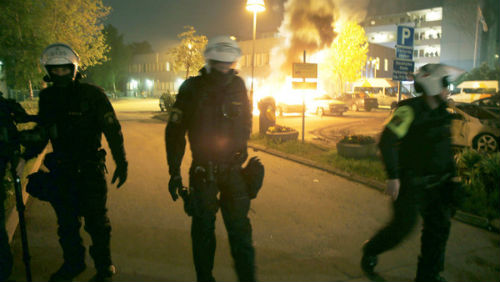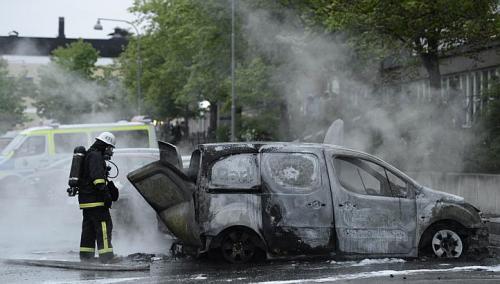CELEBRATION OF NARAD JAYANTI & AWARD OF NARAD SAMMAN -2013
AT BHUBANESWAR
(ODISHA)
Bhubaneswa-31/05-Narad Jayanti was celebrated on 26.5.13 at Bhubaneswar in
the local Jayadev Bhawan with award of
prestigious Narad Samman to the distinguished scholar turned Journalist
Sri Pratap Mohanty .The house was packed
with four hundred patriotic audience intellectuals who enjoyed the function with a cultural ceremonial look .Senior journalist
Sri mohanty was felicitated with “Narad Samman award -2013”,and was presented
with Sal, srifal and a momento having
replica of Debarshi Narad and also with a Cheque of Rs 10,000/-,as a token of
love of the people of Odisha for his
consistent effort for propagating cultural nationalism in the field of
Journalism. For him journalism is not a profession, rather a mission
with social responsibility.
In return of the award Sri Pratap Mohanty told that in mass
media, some groups are working against national spirit. Some are also engaged
in undermining Hindu values. All conscious citizens should raise their voice
against these ill practices. Some media organisations, who are not following
the truth and right values should be ostracized by the people. If the main
media organizations over look these aspects, then people should propagate their value based opinions firmly
through social media. He further told that in Odisha Swami Laxmananda Saraswati
was murdered due to the nexus between Maoists and some elements engaged in
conversion . But outside Odisha this
fact was not highlighted in the media, rather
a propaganda was made that Christians are being tortured by Hindus in
the state.
Chief guest Sri Gopal Chandra Nanda ,IPS,the retired
Director General of Police told that mass media being fourth pillar of
democracy is a guard against corruption in all levels . It has a strong
responsibility for our country which is far below in the ladder of honesty , in contrast to countries
like Newziland and Belgium who are at the top of the ladder . He further told that in the field of unfair sex practices, our country has a low rate of evils in comparison to
other western developed countries, for
which thanks should not go to the police or administration, rather it is due to
our high cultural heritage. He again told that by distribution of rice having
price of Rs-1/- per k.g. will not elevate poverty among people. Rather people
should be made conscious about their poverty and a strong awareness of work
culture with determination can only eradicate poverty from our country . He
further added that Debarshi Narad is not given due importance in our society,
which he ought to be. People wrongly say that “Narad” is present in every place
of disturbance . Rather they should say the right thing that “Narad” appears in
every place of importance to collect, propagate and transmit true and correct news. He praised
the work of Viswa Sambad Kendra for upholding the values of Debarsi Narad .
The Chief Speaker Sri J.Nanda Kumar. the Akhila Bharatiya Saha Prachar Pramukh of RSS
told that “Debarshi Narad” has many fold personalities. He is the Symbol of
water , for which on the eve of Narad Jayanti a hot Bhubaneswar
was made cool by the pleasant rainfal,
which suddenly broke out due to his
blessings. He cited the conversation between Debarshi Narad and king
Judhisthira that depicts his advice in the field of agriculture, commerce, education
, health, administration and information technology .
He further added that the function is about the great
thinker Philosopher, teacher, legislator and last but not the least the first
journalist of the Universe Sri Narada
Muni. It is not proper to confine that
great personality to one particular area. He was asked by his guru when
approached for vidya – what is the extent of your knowledge? Naradji presented
an elaborate list from which we could understand the vast knowledge.
The very meaning of the word
Narada is this as per the learned forefathers
One who imparts the extreme knowledge is known
as Nara + da – ‘Nara
Narada’s presence and
involvement in the making up of the two Itihasas are quiet significant.
Ramayana was written because of Narada. On a fine morning Narada appeared
before Valmiki. Valmiki was in search of a
perfect man with 16 qualities. Narada narrated the story of Purushottama having
57 qualities – Yes, it was the story of SreeRamachandra the incarnate of the
best of qualities – the maryaadapurusha. Enthralled by the story mesmerized by
the narration done by the master communicator Valmiki went for his daily
Sandhya Anushtan to the thamasa river along with Bharadwaja. The calm and
serene atmosphere and the beautiful environment made Valmiki's mind more
creative. It was the moment when Valmiki witnessed a hunter shooting down
one of the burds of the kowncha pair – From the depth of his pain and despair
Valmiki uttered ‘Ma Nishada’ – Do not do that – Thus was born the first poem or
sloka. Immediately after that utterance and its subsequent impact Valmiki asked
his companion. What is this that I have uttered, what sort of things are
these lines constructed with a rhythm and a particular pattern just like the
notes of Veena. Is this, which came out of my pain, a sloka ? He returned to the
hermitage to seek out Brahma Dev and to direct him to write about Rama in the
style and pattern of the slokas he had uttered. Thus was born - Ramayana.
Narada was present at every critical juncture of the story
line. He corrected the mode and mood of the story flow. He was instrumental in
putting the things in order. He never allowed the minds to go out of focus.
Narada’s extraordinary skill in interpreting Dharma and keeping the concerned
characters well aware about the going keenly are explicit in almost every
Puranas.
In Mahabharat his dialogue with
Dharmaputra was the wonderful elucidation of the methodology of
Governance and the a Gita for administrators.
Devarshi Narada entered the unique assembly of Maharaja Yudhishthira.
Satisfied with the hospitality of Dharmaputra, NaradaMuni gave him the true
knowledge of Purushartha, the four stages of Dharma-Artha-Kama-Moksha. The
instruction was in the form of Catechism, ie.
in the form of answers to pre -formulated questions. It was in a question
answer form and a true elaborate list of the duties of a ruler. He asked 123
questions on the code of law and obligations of the Government. Those rules
& regulations, explained thousands of years ago, are more relevant
today. Well, all are aware about the
Ramarajyam concept of Mahatma Gandhi – No doubt this can be taken as its
practical application. Yes these duties are morally and legally inevitable. But
moreover obeying and living according to the principles elaborated in Narada’s
discource was meant to lead a person to
a higher plane of spirituality. It was not just a formula for material
advancement or regulating mundane affairs.
Good Governance is a matter of grave relevance today. I say
this because matters are indeed grave.Each and every institutions and systems
connected with the so called democratic government had gone far away from the
common people, on whose name the whole set up has been formed. Truthfulness,
sincerity, values haven’t got any position or role in the whole scheme of
affairs. Affairs are governed by selfishness, crookedness, one- upmanship. It
is not proper to blame the foreigners for our faults.
Those systems, structure and methodology formulated
by Englishmen are being continued shamelessly by the independent India
Same is the case of Education, History, Industry and
Economics, everywhere the alien presence can be felt. Our rulers were not ready
to take up models from our own history and traditions. On the other hand Look
at Narada . Narada formulated 123 points or 123 questions specifically
connected with the ‘Suraj.’ And the interesting part is that Yudhishtira didn’t
give answers one by one to every question. He gave his answer as a whole and in
the end clarified that every step he took till then were according to the
directions given by Naradamuni.
Broadly we can divide those questions into 5 parts.
The first part is on Dharma. First of all he asked “Oh Dharmaraj, are you
thinking about Dharma along with Arthachinthan? Is the Arthachinthan
overshadowing your Dharma chinthan?”
Is the desire for material welfare putting a block
on your way to achieve Dharma. But along with that he asked whether your
extreme involvement in Dharma made the treasury vacant. – Does the indulgence
in sensual activities affect your effort to accumulate wealth and attaining
Dharmic Values.
Second group of questions are related with the
matters /factors of social development. He asked the King about 7 departments.
1. Agriculture 2. Commerce 3. Security (repairing
and maintenance of forts.) 4. Building of bridges (roads.) 5. Grassing area for
cows. 6. Tax collection from gold & other precious stones mines. 7.
Building of new Basthis. )
He was very much specific about those departments.
As an example I shall put before you his directions regarding Agriculture. Can
you say that the farmers in your Kingdom are satisfied and wealthy? Have you
not made sincere efforts to make Tanks, lakes and ponds filled with water for
the irrigation purposes? Is Agriculture dependent on solely the monsoon? What
about seeds and food for farmers? Did you not allocate loans for farmers as and
when the situation demand?
Think about the affairs of agriculture today. We are
seeing the plight of farmers. Plan money allocated is dwindles year by year.
Sufferings resulting in the suicide of farmers is increasing. It is not
suicide. It is mass suicide.
Third group of questions were about ministers and
officers. Have you not selected members of your ministry from persons with exemplary
nature, spotless character, and social commitment? Are you not running the
different departments of the Government with sincere, non-greedy, service
minded, knowledgeable officers? Are you remembering the old saying that ‘one
knowledgeable person is better than 1000 fools. Are you not appointing
apt persons for the jobs looking into or considering the level and demand of
the field? (Can you compare this with today criteria of selection ?) Are
you not appreciating the good work done by the ministers – who are looking
after the treasury, warehouses, vehicles, security at the gates, Armament
depots etc. Are they not from clean personality with rich traditions and
character? Do you remove or punish expert, sincere and welfare seeking officers
and workers without any false of theirs?
Are you not
looking after your citizens with the feeling and love of a caring father and a
loving mother? I hope that none of your countrymen would raise fingers against
your sincerity, impartiality. What about the womenfolk, are they not safe and
participating in the social activities? How far the system created for the
well-being of the physically challenged persons are functioningproperly? Are
you not attending the need of Sanyasis with a father like affection and sense of
belonging?
One peculiar and specific question which is very
much relevant today is as follows: Are you sure about your officers that they
are not freeing the thieves who were caught red handed out of the greed over
the wealth they looted? What are going on now? See what happens
now-a-days? How has the corruption became so rampant?
Likewise Narada asked about King’s daily routine, at
what time you are getting up? Are you not contemplating upon the work to be
done? Analysing the work which was done? How you are taking decision, alone or
after taking suggestions from many? How you are looking after the kith and kin
of those sincere persons who had laid down their lives for the security and
well being of the nation and society as if they are your own sons, daughters?
Are you not hearing the suggestions and teachings of the great knowledgeable
personalities having splendid experiences with rapt attention? Have you not
kept away 6 doshas like slumber, laziness, fear, anger, procrastination and
long enmity.
Questions connected with security, war preparedness,
espionage, war strategy were also asked. Narada raised these issues not only to
enlighten the Kings and rulers but also to awaken the general public about
their rights or what all can be they expect from the Government. If we want to
make some plan for good governance these questions raised by Narada can be
taken as apt reference. It has got the strength and depth to show the way. Every point is relevant and it should be
analysed minutely.
Narada was always active in his effort for
propagating Dharma and people’s welfare. In our scriptures he was equated
as the Bhagawan’s mind. That is why through all ages, among all peoples,
in all philosophies , with all groups of society, Naradji was welcomed and
received, not only by Devatas, Danavas
too respected him always. Time to time they all took advice from him. In
Bhagavad Geeta Bhagavan Sreekrishna placed him on a highest pedestal and
explained him as first or best among all Devarshis.
In the fifth chapter of Mahabharath’s Sabhaparva
Naradji was explained as the Knower of Upanishads, adored by Gods, specialist
in Ithihas and Puranas.
Along with all these virtues he was a master
communicator. Narada was considered to be the first reporter or journalist of
the whole Universe. He knew the crux of the journalism. His mastery over
journalism and expertise in communication was shown when he gave tips to
Yudhishthira on governance. Some of the points we have seen. At another
occasion he told Yudhishthira that the power of the common people is totally
based on how they are informed. They should know how things are going on all
over the world. So a responsible ruler should make necessary proper machinery
and system to make people aware about the facts.
All the qualities of a good journalist are in
Narada. First quality is that the understanding of the situation in depth.
Exactitude and comprehension are needed very much for a journalist. Next is the
ability to analyse the information. Along with that he should collect and study
the whole details. Another aspect is the capacity to foresee the after effect.
And the most important quality is articulation. Considering all the facts
explained earlier he should communicate the news or information to the peoples
in a proper way, using proper words.
In the Adiparva of Mahabharata Vedavyasa had given a
complete picture of Narada.
Only few are discussed here.
Vedavyasa at that particular occasion had given 29 slokas to elaborate the
qualities of Narada.
After understanding the
situations thoroughly, taking all related factors
into consideration NaradaMuni used to communicate without making any ambiguity.
He is well versed in different aspects of the Dharma and also an expert in
implementing it’s properly. He knows the different shades of the meaning of the
word and also different word having same meaning. He never failed in using the
exact word. Such was his command over language and his power of vocabulary. A
true journalist should present the news before the society with comprehensive knowledge
of the matter. For that purpose he should study Sincerely. Without which
communication would become irresponsible and dangerous. So many incidents can
be elicited here as examples. The cut and paste capacity would play havoc in
journalistic activities. Narada gave only authentic knowledge for he was in
procession of the complete knowledge. This specialty of Narada was
authenticated by none other than Vedavyasa. Reporting should essentially be
with a sacred purpose. In order to increase the rating reporter shall not adopt
any cheap immoral techniques.
A journalist shall not do these dirty tricks with
selfish and other ulterior motives.
1. Shoot and Scoot.. ( eg: see how Poojaneeya
Sarsanghchaalakji's speeches at Silchar and Indore
2. Cut and Paste.. You should have the complete
knowledge for that purpose you should study in depth cross check and proceed.
Pan cake intellectualism as Richard Foremen had put it sharply is a bane of
journalism and the same is playing havoc everywhere now a days.
3. Stoop and Rate... Stooping to any level to
increase the rating .. For that matter positive things are put under
carpet and nasty negative anti national news are placed on the front page and
prime time.. ( eg: Maj Maneesh peetambare's dare devil action against terrorist
and his heroic death was not aired or printed but on that very day channels and
papers were madly running after Sanjay Dut's bail... Both happened on the same
day of 2007...)
A great writer and author of several standard texts
including ‘Narada Smruthi’ Narada is known as a ‘Walking Monk.’ Who used to
travel all three Lokas communicating each other? Narada was known as a person
who used to cultivate disputes among Gods and others with his communication
practices. Without knowing the real purpose of those practices many of us
called him war monger ‘Kalahapriya’ etc. But Narada used those disputes only to
resolve complex problems and to restore Dharma and Peace.
On this occasion a book ‘BEDA BANDITA SARASWATI &
SARASWATA SABHYATA’ written by Prof. Dr. Nagendranath Pradhan was inaugurated
by the chief guest. The programme ended with ‘VANDE MATARAM’ song delivered by
the girl students of Unit-8 Saraswati Sisu Vidya Mandir,Bhubaneswar .




 Chief Guest P Rajan, a fearless journalist, said that in ancient India communication system was so elastic yet effective that even the kings could be questioned for their wrongdoings and they had to explain. This openness was the basis of our democracy and media and not the vote bank, he said while inaugurating the Narada Jayanti program.
Chief Guest P Rajan, a fearless journalist, said that in ancient India communication system was so elastic yet effective that even the kings could be questioned for their wrongdoings and they had to explain. This openness was the basis of our democracy and media and not the vote bank, he said while inaugurating the Narada Jayanti program. नई दिल्ली, 30 मई :विश्व हिंदू परिषद (विहिप) का उच्च स्तरीय प्रतिनिधि मंडल वरिष्ठ संतों के साथ गुरुवार को राष्ट्रपति से मिला और रामजन्म भूमि समस्या के समाधान के लिए संसद में कानून बनाने की अपनी मांग दोहराई।
नई दिल्ली, 30 मई :विश्व हिंदू परिषद (विहिप) का उच्च स्तरीय प्रतिनिधि मंडल वरिष्ठ संतों के साथ गुरुवार को राष्ट्रपति से मिला और रामजन्म भूमि समस्या के समाधान के लिए संसद में कानून बनाने की अपनी मांग दोहराई।